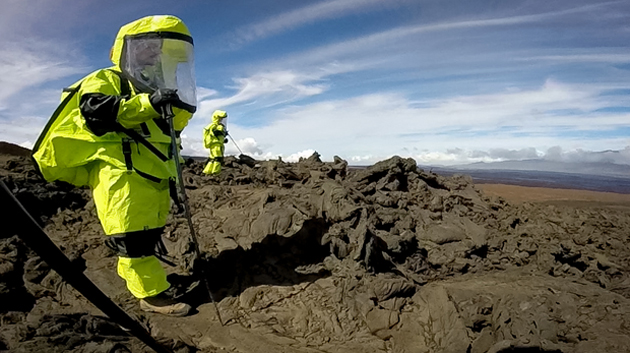
For one record-breaking year, six Mars-simulation crewmembers ate, slept, worked and played in their isolated habitat on the slopes of Mauna Loa, for the Hawaiʻi Space Exploration Analog and Simulation or HI-SEAS project operated by the University of Hawaiʻi at Mānoa.
“A mission to Mars would be two-and-a-half to three years long. So if you really want to test out your people and your systems and how well they work together, you need to have those long durations,” explained HI-SEAS principal investigator and UH Mānoa Professor Kim Binsted.
Crew commander Carmel Johnston said,“Living in a dome for year is incredibly like a gigantic mission in itself, but going for three years to Mars is going to be that much more.”
The simulation allowed for walks outside the habitat, but only with a space suit on, so the crew could not feel the sun or the wind. Email communication also had a 20 minute delay to simulate long duration space travel.
“I would encourage anyone who wants to be an astronaut, come try something like this,” said crewmember Andrzej Stewart, who aspires to be an astronaut. “It’ll be a chance to get a little bit closer to that dream.”
After their year in isolation, crewmembers also have practical advise for future “lavanauts.”

“Space, interestingly, is about what you value about Earth,” observed Sheyna Gifford, the crew’s medical doctor. “If your values are very much people and science and hard work, and if you are intrepid, then this is for you.”
French crewmember Cyprien Verseux said, “I think what made the mission much easier, at least for me, was having stimulating projects and doing research which I could only do here.”
German crewmember Christiane Heinicke concurred, “If you have something meaningful to work on and if you can keep yourself busy the whole time then you are also more likely to be a pleasant crew member yourself.”
“If you can work on something that’s self-developmental and makes you more than you were, you will not go crazy,” said UH Mānoa doctoral candidate and crew architect Tristan Bassingthwaighte.
“Bring a ukulele,” advised Verseux, who taught himself to play over the year and bought a Kamaka ukulele soon after exiting the HI-SEAS habitat. “Playing music helps a lot.”
Words to remember for the next two HI-SEAS missions, which are scheduled for 2017 and 2018.
—By Kelli Trifonovitch

